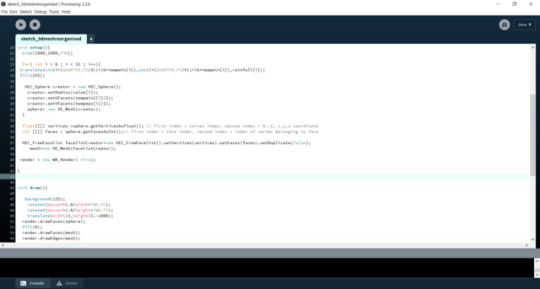Text
My final code generated object was created from weather statistics from any chosen area. Basic compositional features of importance are its circular formation, characteristic of the cyclic nature of the sun, seasons(weather) and months etc. Major controlling features are the size of each led by sphere is controlled by average wind speed inputed as the sphere radius. The second key function is the number of faces on each segment which is affected by minimum and maximum temperature through the spheredetial function. this creates an interesting feature where the less faces present the warmer the day was. Rainfall controls the Y axis displacement of each section using the translation function. the final feature is the distance each section is from the centre. The whole sketch is made possible by using for loops and data arrays to make it easy to change data sets.
0 notes
Text
Source Codes
Processing Version with OBJexport library, Used to create printable mesh
https://www.openprocessing.org/sketch/460962
HE_mesh version, used to create images
https://www.openprocessing.org/sketch/461597
0 notes
Photo

This is an experiment with data sets created from other city weather statistics. The end result for this project could include multiple objects that each represent different cities
0 notes
Photo






Photoshopped images of the object in possible contexts. I feel it has the best impact in the more public spaces where it can be recognised within the environment it sets out to visaulize.
0 notes
Photo










Images of the Final printed object, still featuring the printed support as it both supports the structure standing up straight and helps make aspects of the object easier to understand; predominantly the different heights of each section
0 notes
Text
Sketch File
https://www.openprocessing.org/sketch/460962
uses OBJexport library.
0 notes
Photo



Netfabb editing;
In netfabb all that was needed was to rescale the model and change it so it was flat on the ground
0 notes
Photo

This model still has some inconsistencies but to a lesser degree. This was achieved by changing the number of vertical facets on the sphere from the max the minimum temperature array divided by two, to just the raw value. making it overall smoother. from here i can now move it into Autodesk netfabb to check for any errors
0 notes
Photo


To orientate the spheres the right way i changed the order of functions with the translate function so the ring builds on a different axis, thus making the sphere the right way
NEW FUNCTION;

OLD FUNCTION;

I was finally able to successfully export the shape, however i wasnt quite happy with what happened to the tops of the every sphere so i delved back into the code to attempt to remedy it.
0 notes
Photo


This attempt to create an exportable file saw me try a different library that export OBJ files. however to use it I had to revert back to the standard processing sphere functions. the first problem I encountered was that the sphere detailing was horizontal on the meshes.
0 notes
Photo

From the previous experiment i tried setting up the code as it is in many of the Example files, with the meshes established in the setup function and the rendering of them done in the draw function. however multiple errors that i couldn't remedy made me unable to use it.
0 notes
Photo

Another solution i tried was adding another function to create a single mesh that calls upon existing meshes to define its shape. From the He mesh examples i was able to pull this function

which creates an array of points from an existing mesh that can then be reused by calling on HE_mesh facelist. however i was again thwarted by the for loop and it would only create from the singular mesh (seen in black).
Back to the drawing board.
0 notes
Photo


The first solution that i attempted was to place the export function within the for loop so that it runs with each iteration, the result produced all 32 meshes. however they were all saved independently and no longer had the orientation inputs. it was possible to import all the meshes into autodesk inventor to compile them, but the task to place them back in a ring was near on impossible. therefore i must continue to search for a solution.
0 notes
Photo

First attempt to export the mesh. The result was the mesh for a single segment of the ring geometry. Deductively i assume that it caused by the for loop which is replacing the previous mesh each loop. this means that when “mesh” is called upon in the export function it is only exporting the last mesh to be created in the loop.
0 notes
Photo




For the final few steps i encountered the problem that i could not export the sketch to .stl in its current form as it had no mesh properties. Therefore i had to rewrite parts to include the HEmesh functions to allow me to export it
0 notes
Photo


Continued development of the concept, Adding more arrays with maximum and minimum temperature, this time however using the int function, this allows me to use this array in the sphereDetail function to allow the smoothness of each segment to be influenced by how warm a day was overall.
0 notes
